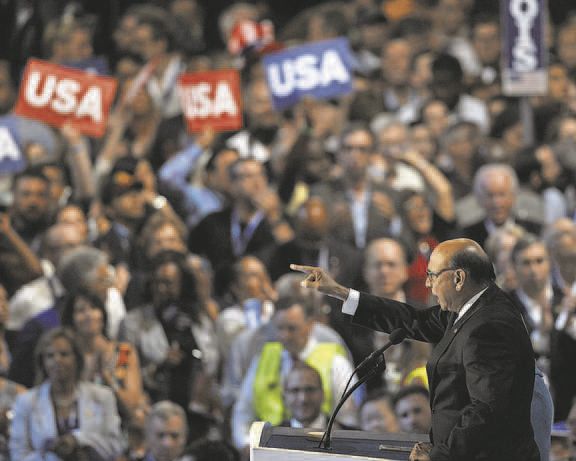By Philip Sean Curran, Staff Writer
In a span of two weeks in July, photographers Phil McAuliffe and Rebecca Nowalski recorded history, first in Cleveland and then in Philadelphia at the national political conventions.
From the sublime to the ridiculous, they photographed celebrities and protestors, captured images of the next president and the person who will lose the presidency, slogged equipment, had brushes with celebrities and endured the travails of covering major news events.
“It was a circus at both of them. There was a lot going on,” said Mr. McAuliffe in an interview Thursday.
He and Ms. Nowalski, who do freelance work for the Packet, were shooting for Polaris, a photo agency headquartered in New York City. Aside from his duties taking pictures, Mr. McAuliffe also was in charge of the team of Polaris photographers in Cleveland and Philadelphia.
“A lot of times, it was (an) around the clock deal,” Mr. McAuliffe said of the hours he put in.
For Mr. McAuliffe, he had covered five prior conventions starting with the GOP convention in 2000, also in Philadelphia, during his 30 years as a photographer. For Ms. Nowalski, this would be her first time in an eight-year-career.
Both were familiar with the candidates, having photographed them during the primaries. For Ms. Nowalski, that experience provided her with insights that she could not get anywhere else.
“It’s a different way of looking at politics, because you’re not only firsthand getting to see the candidates and what their staffs are like, you’re also seeing what the supporters coming out to see them are like, which I think is much different than just reading about it in the news or seeing it on TV,” she said.
“Because there’s a vibe that goes along with each candidate that you get a sense of every time you go to one of their events or one of their rallies,” she continued. “So it gives you a much different view on who’s running because of that vibe that goes on around that person.”
Yet there also was a practical benefit, too, when it came to doing their jobs. Photographing them before, Mr. McAuliffe said, enabled him to get “more familiar with how the campaign sets up where you shoot from,” like a side view or straight-on position.
“Sometimes, depending on the venue and how much press is there, they may give you buffer access,” he said of when a small group of photographers are given close-up access to the candidates.
Mr. McAuliffe shot inside and outside the arenas in both cities, while Ms. Nowalski captured the action outside looking for things to photograph.
“Lots of times, there wasn’t very much to look for. It was right in your face,” she said. “It seems that the start of both of the conventions, there was stuff just everywhere. And then it kind of petered off in both weeks.”
Security was tight in both places. In Philadelphia, a lot of the protests took place in Center City — miles away from the arena in South Philadelphia — with marches down Broad Street.
“Philadelphia, in a lot of ways, was harder than Cleveland,” Mr. McAuliffe said, “because everything was spread apart.”
“Philadelphia was rough, really rough,” added Ms. Nowalski, who got heat stroke the first day. “To do a day of protests and try to hit different areas of things that are going on, you’re talking miles and miles and miles and miles.”
Safety was another consideration. Mr. McAuliffe mentioned one tense moment, in Cleveland, where Black Lives Matter demonstrators clashed with white supremacists. “And I was kind of right between them, me and a few other photographers, and it got pretty heated,” he said.
Ms. Nowalski recalled two flag burnings — one in each city. Mr. McAuliffe said he noticed that, at the protests, there were a lot of anarchists who showed up and that he saw a lot of the same faces in Philadelphia that he had seen in Cleveland.
“A lot of the protestors are the same, you have to be really careful because you start photographing the same people between both cities,” she said.
In looking at his pictures from the two weeks, Mr. McAuliffe believes his best work came on the last night of the Democratic convention. His favorite image is one he took of Bill and Hillary Clinton embracing on the stage, with someone in the crowd holding a sign reading “together.”
Ms. Nowalski’s favorite is of a man marching on Broad Street in Philadelphia, with his hands in the shape of a heart and City Hall framed in the background. She recalled it was the one “demonstration that was really positive and full of love.”
“That was the most positive event out of the whole two weeks,” she said.
Yet there was a moment missed when Gold Star father Khizr Khan spoke at the DNC.
“I didn’t know who he was, and I was just shooting scenes in the hall, and then he held out the Constitution and the place erupted,” Mr. McAuliffe said. “So I quickly tried to get the lens back onto him, but by the time I got him framed in, he had just put it down.”
For Mr. McAuliffe, he plans to be out on the campaign trail and intends to look into covering one of the debates.

